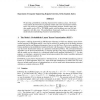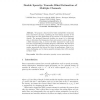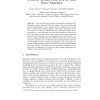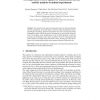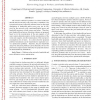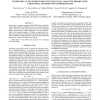ICA
2010
Springer
13 years 11 months ago
2010
Springer
We develop a probabilistic modeling framework for multiway arrays. Our framework exploits the link between graphical models and tensor factorization models and it can realize any ...
ICA
2010
Springer
13 years 11 months ago
2010
Springer
The problem of estimating a sparse channel, i.e. a channel with a few non-zero taps, appears in many fields of communication including acoustic underwater or wireless transmissions...
ICA
2010
Springer
13 years 11 months ago
2010
Springer
We propose a framework for blind multiple filter estimation from convolutive mixtures, exploiting the time-domain sparsity of the mixing filters and the disjointness of the sources...
ICA
2010
Springer
13 years 11 months ago
2010
Springer
Most of audio source separation methods are developed for a particular scenario characterized by the number of sources and channels and the characteristics of the sources and the m...
ICA
2010
Springer
13 years 11 months ago
2010
Springer
We describe in this paper an advanced protocol for the discrimination and the classification of neuronal spike waveforms within multichannel electrophysiological recordings. Sparse...
ICASSP
2010
IEEE
13 years 11 months ago
2010
IEEE
In this work, we look at single user and multiuser Multiple-Input Multiple-Output (MIMO) beamforming networks with Channel Distribution Information (CDI). CDI does not need to be ...
ICASSP
2010
IEEE
13 years 11 months ago
2010
IEEE
The resource allocation problem in wireless multi-user decode-and-forward (DF) relay networks is considered. The conventional resource allocation schemes based on the equal distri...
ICASSP
2010
IEEE
13 years 11 months ago
2010
IEEE
We present a novel weighted approach for shrinkage functions learning in image denoising. The proposed approach optimizes the shape of the shrinkage functions and maximizes denois...
ICASSP
2010
IEEE
13 years 11 months ago
2010
IEEE
In this paper, we propose a symmetrical EEG/fMRI fusion algorithm which combines EEG and fMRI by means of a common generative model. The use of a total variation (TV) prior as wel...
ICASSP
2010
IEEE
13 years 11 months ago
2010
IEEE
The energy-distortion function (E(D)) for a network is defined as the minimum total energy required to achieve a target distortion D at the receiver without putting any restricti...
